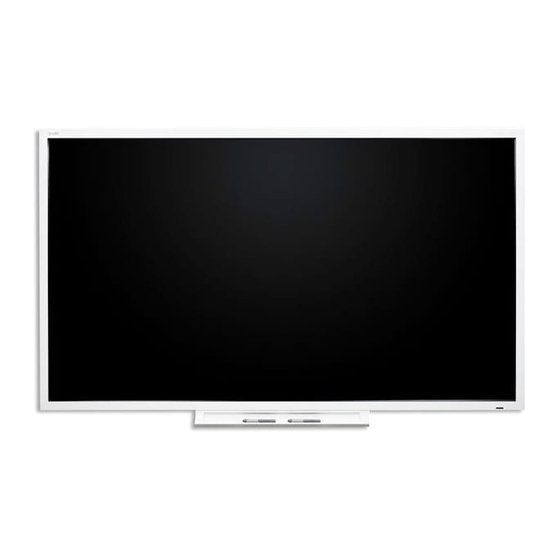
Summarization of Contents
Installing the SMART Product
Moving the SMART Product to Installation Site
Guidance on safely transporting SMART products to their installation location.
Installing the SMART Product on a Wall
Steps and considerations for securely mounting SMART products onto various wall types.
Installing the SMART Product on a Stand
Instructions for installing SMART products on stands, including third-party and mobile options.
Power Management and Room Control Systems
Integrating SMART products with power management features and external room control systems.
Configuring the Product
Calibration and Orientation
Ensuring accurate touch input by calibrating and orienting the SMART product's display.
Resolutions and Refresh Rates
Optimizing image quality by configuring connected device resolutions and refresh rates.
Configuring for Best Audio Performance
Adjusting settings and environment for optimal audio output and clarity.
Other Configuration Tasks
Final configuration steps and referring to product documentation for additional setup.
Product Accessories
OPS Computers
Information on SMART's Open Pluggable Specification (OPS) computers and their requirements.
Room Cameras
Guidelines and requirements for selecting compatible USB cameras for SMART room systems.
Speakers
Specifications and guidelines for choosing external speakers to complement SMART products.
Microphones
Requirements and guidelines for selecting microphones for classrooms and conferencing.
Room Controls
Connecting third-party external control systems to SMART products via RS-232.
Cables and Connectors
Cable Best Practices
General guidelines for selecting, using, and maintaining high-quality cables for reliable connections.
Power Cables
Requirements for power cables, including country-specific standards and load current ratings.
Analog Audio Cables
Details on unbalanced, balanced, and powered analog audio cables and their connectors.
Digital Audio Cables
Information on digital coaxial and optical audio cables, including their types and connectors.
RS-232 Cables
Understanding RS-232 serial communication standards and cables for data transmission.
DVI Cables
Information on Digital Visual Interface (DVI) cables and connectors for video transmission.
VGA Cables
Details on Video Graphics Array (VGA) analog cables and connectors for video connections.
HDMI Cables
Guide to HDMI cable types, versions, resolutions, and refresh rates for optimal video/audio.
DisplayPort Cables
Information on DisplayPort cables, their characteristics, and compatibility with SMART products.
USB Cables
Overview of USB cable types, connectors, versions, and their use with SMART products.
Ethernet Cables
Guidelines for selecting and using Ethernet network cables for connectivity.
Cable Accessories
Adapters and Converters
Information on adapters and converters for connecting different cable types and signal formats.
Couplers and Extenders
Guidance on using couplers and active extenders for connecting and extending cables.
USB Cable Extenders
Using USB extension cables and hubs to extend USB connections beyond standard lengths.
Video Cable Extenders
Using active video extenders to maintain signal integrity for longer video connections.
Source Switching
Methods for switching between multiple input sources for SMART products.
SMART Reliability Testing
Cable Standards Testing
Overview of interface standards (HDMI, DP, USB) SMART tests its cables against.
Mechanical, Electrical, and Safety Standards Testing
Details on SMART's testing for mechanical, electrical, and safety standards for product reliability.














Need help?
Do you have a question about the Table and is the answer not in the manual?
Questions and answers